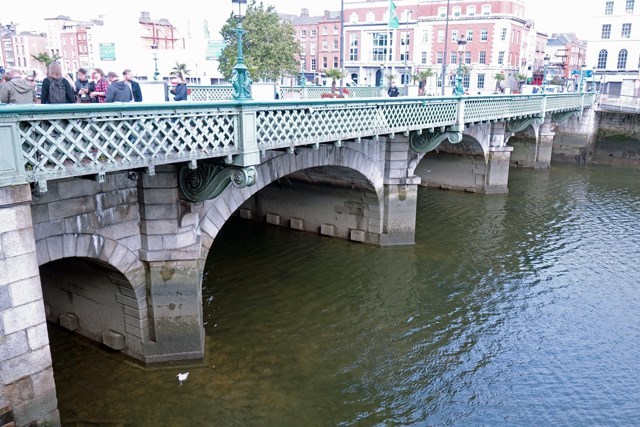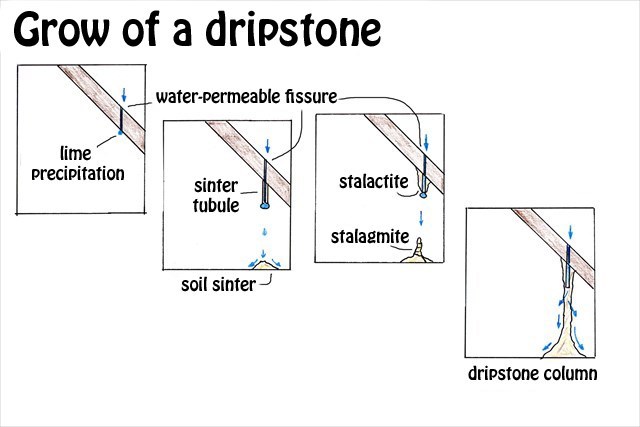This is a T5 Earthcache that could be done by boot or kayak.

The Essex Bridge
Closely modelled on the London’s celebrated Westminster Bridge, George Semple’s design for the Essex bridge was 7 feet wider, though naturally shorter.
Essex Bridge was opened in 1755 and was replaced by the present Grattan Bridge.
As is tradition among Dubliners, the name used locally for the bridge will vary from Capel Street Bridge, to Grattan Bridge and the original Essex Bridge.

Definition of stalactite
A stalactite is a dripstone hanging from the ceiling of a cave. The name derives from the ancient Greek στάλαγμα (synonymous with σταλαγμός, "drop").
Formation
The rain absorbs carbon dioxide from the atmosphere, seeps into the soil, where it also absorbs organic acids. The calcium carbonate (lime) dissolved, from the limestone in the water. This dissolved lime combines with the carbon dioxide to calcium bicarbonate, which is highly soluble in water. When reaching a cave ceiling, this solution drips through existing rock fissures. In contact with air the carbon dioxide escapes, the calcium bicarbonate is transformed back into the poorly water-soluble calcium carbonate (lime). The water evaporates, leaving lime, which forms the stalactites over millennia.
Chemical equation
Ca2+ + 2 HCO3− ⇔ CaCO3 + H2O + CO2
or
Ca2+ + 2 HCO3− ⇔ CaCO3 + H2CO3

Dripstones made of other materials
Dripstones are not just made of lime. In the visitor mines Feengrotten in Saalfeld, Morassina in Schmiedefeld (both in Thuringia, Germany) and Alaunwerk Mühlwand in Reichenbach (Saxony, Germany) you can admire colorful specimens from diadochit-dropstones. Diadochite stalactites grow much faster than lime stalactites, but are less mechanically stable.
Icicles are similar to stalactites and can therefore form comparable shapes.
The small, inconspicuous sintered warts in sandstone karst, are made of SiO2, They can be observed all over the world.
Growth rate and dripstone age
Dripstones are formed and grow very slowly on a human scale. However, the exact growth rate of the stalactite growth varies and depends on several factors:
· lime concentration in the water
· CO2 content in the water and in the cave
· amount of dripping water
· temperature
A very popular information during cave guiding tours is the growth rate of stalactites. Realistic measurements of 8 to 15 millimeters per 100 years are taken as a basis. However, the generalization to the entire cave, as well as the linear extrapolation to the drip stone size is not legitimate. A one-meter long stalactite is unlikely to be exactly 10000 years old.
In the “Charlotten Cave” you can see a three-centimeter dripstone that has grown on the lines of historic electric lighting. So, the age is known (since the installation of the line, about 110 years) and it is possible to calculate the growth rate. Unfortunately, the result cannot be generalized, and adjacent dripstones can have very different growth rates. The mentioned dripstone is located under a sinkhole with humus filling and very high CO2 and Humic acid production. The growth rate is very spatially limited.
Significantly, environmental conditions also influence growth. Growth rates vary with climatic changes as the four parameters, given above, change. In the alternation of cold times and warm periods, the growth fluctuates very strongly. During a cold period, the sealing of the soil due to the formation of permafrost may interrupt the growth. In the last warm period, it was warmer and humider weather than today, so the growth rates may have been higher. Presumably, in the above example, a considerable part of the stalactite was created before the last glaciation. Growth was interrupted and continued only after the end of the cold period about 8000 years ago. In general, the age of a stalactite, means today, the warm period, during which most of the stalactite was formed.
However, the growth rate is an important indication when it’s derived from good measurements. For this purpose, samples are taken and the age determined with a suitable geophysical method for age determination (14C, U/Th or O). Now, a good growth rate can be calculated between suitable measuring points, with identifiable homogeneous growth in between. This allows conclusions about the climatic conditions during the formation of the stalactite.
Growth disturbances
The growth of the stalactites can be disturbed by cave visitors. If a stalactite is touched, fat is removed from the skin and prevents future calcification at this point.
Stalactite occurrence
Basically, you can find stalactites in all caves worldwide, which are located in karst and limestone regions. These caves are called stalactite caves.
Dripstones can also form on older structures when calcium hydroxide is released from cement or concrete and then reacts with the carbon dioxide in the air.

Logging conditions:
Answer the following questions correctly and send me your answers.
You are allowed to log directly. I will contact you if there is a problem with the answers.
1) What counterpart to stalactites could you normally expect on the ground?
2) Determine the color and the average size of the stalactites? Calculate the theoretical age?
3) What is the age of the Grattan Bridge? Information board at WP2 (not 1755)
4) Does the age of the bridge fit to the calculated age of the stalactites under the bridge? Are they made of lime?
A photo, to the log is not mandatory, but would be nice.
Source: Wikipedia and information board